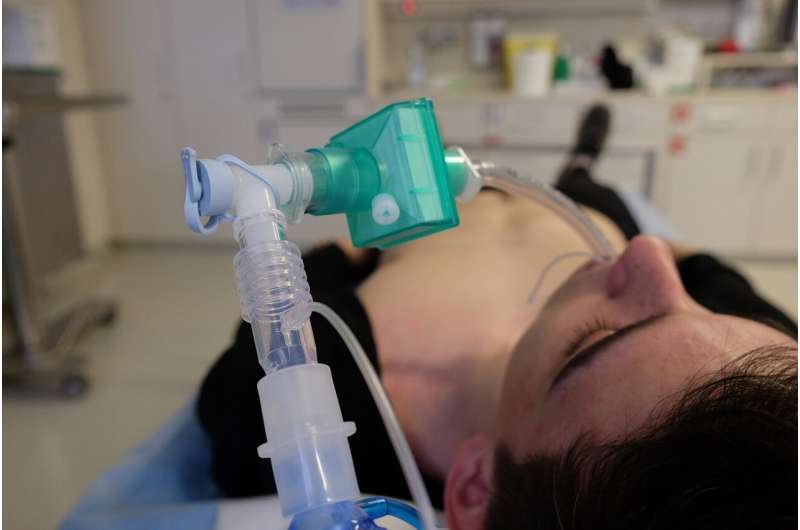New guidance to prevent the tragedy of unrecognized esophageal intubation

Esophageal intubation describes the unintended insertion of a breathing tube into the esophagus (the tube leading to the stomach) instead of the windpipe (trachea). If this is not promptly recognized it causes brain damage or death. There have been a few high-profile cases of unrecognized esophageal intubation recently, and often such cases result in the deaths of otherwise well patients having routine procedures.
New guidance published by Anaesthesia provides the first ever consensus guidance on this subject, designed to reduce avoidable deaths and injury. The authors are an international team that include Dr. Nicholas Chrimes, Consultant, Department of Anesthesia, Monash Medical Center, Melbourne, Australia and Professor Tim Cook, Consultant in Anesthesia and Intensive Care Medicine, Royal United Hospitals Bath NHS Foundation Trust, Bath, UK, and Honorary Professor, School of Medicine, University of Bristol, UK.
Mistakenly inserting the breathing tube into the esophagus instead of the trachea can occur for a variety of reasons including distorted anatomy, technical difficulties, clinician inexperience or movement of the tube.
Esophageal intubation is relatively common. Every airway management clinician would have mistakenly intubated the esophagus on multiple occasions during their career. Usually this is rapidly identified and does not result in harm. Not recognizing that esophageal intubation has occurred is extremely rare but nearly always fatal. One UK survey found that it caused six deaths in a single year. However, as publicly reporting these events is not mandatory, determining the exact incidence is difficult.
Usually, esophageal intubation is easily detected and corrected without causing any harm. In most settings (and routinely as a standard of practice during anesthesia in most high-income countries), monitors are connected to the breathing tube that detect carbon dioxide, which is only produced by the lungs and isn't present in the stomach. Detecting carbon dioxide therefore usually confirms correct placement of the breathing tube in the trachea. If carbon dioxide is not detected this usually indicates the breathing tube is in the esophagus.
In cases of unrecognized esophageal intubation, the inability to detect carbon dioxide following placement of a breathing tube is often mistakenly attributed to the occurrence of cardiac arrest. However, while a cardiac arrest is a frequent consequence of the lack of oxygen resulting from esophageal intubation, when the breathing tube is correctly placed in the trachea, cardiac arrest due to other causes should still result in some carbon dioxide being able to be detected. The guidelines therefore re-emphasize earlier advice that cardiac arrests should not result in the complete absence of carbon dioxide unless the breathing tube is incorrectly placed.
The new guidance also emphasizes removing the breathing tube immediately as a precaution if carbon dioxide cannot be detected, unless this would be dangerous, which is rarely the case. In the unusual situation where removing the tube by default is thought to place the patient at risk, clear recommendations are provided on alternative ways to exclude esophageal intubation and correct other causes of absent carbon dioxide.
It also recommends that exhaled carbon dioxide monitoring and pulse oximetry (which measures oxygen levels in the blood) should be available and used for all procedures that require a breathing tube, and that a videolaryngoscope (an intubation device fitted with a video camera to improve the view) is used to insert the breathing tube whenever possible to ensure correct placement. Another factor that has contributed to some of these tragic deaths is mistaking other similar looking readings on monitors for carbon dioxide—so the guidance recommends standardizing and improving the distinctiveness of how these readings are displayed on the screen.
Beyond these technical factors, the new guidance notes the contribution to these tragic outcomes made by the stress and confusion that arises, even among experienced medical teams, when such emergencies occur cannot be underestimated. The impact of such factors on the management of crises has long been recognized in other safety conscious industries such as aviation but is a relevantly recent addition to the understanding of adverse outcomes in medicine. Techniques are advocated by the guidance to help address this.
The authors conclude that "the continued occurrence of death and serious harm from unrecognized esophageal intubation worldwide suggests that an approach to prevention solely focused on stressing removal of the tube if no carbon dioxide is detected is not a complete solution. This guideline emphasizes this point but also provides a more comprehensive approach that addresses both technical and human factors-based contributions to the occurrence of unrecognized esophageal intubation. The emphasis is on the trigger for tube removal being identification of an unacceptable risk rather than a definitive diagnosis that it is misplaced."
Dr. Mike Nathanson, President of the Association of Anesthetists, says that "as the authors note, cases of unrecognized esophageal intubation still occur and may, sadly, lead to death or brain injury. We welcome this important international initiative; we hope the guidance will be widely disseminated. Prevention of future incidents requires education, technological innovation, and a better understanding of the human factors involved. The suggestion of two-person confirmation of the presence of exhaled carbon dioxide is welcome, and we hope this can be introduced into clinical practice."
More information: N. Chrimes et al, Preventing unrecognised oesophageal intubation: a consensus guideline from the Project for Universal Management of Airways and international airway societies*, Anaesthesia (2022). DOI: 10.1111/anae.15817




















